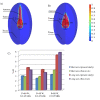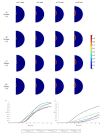Use of microwave ablation for thermal treatment of solid tumors with different shapes and sizes-A computational approach
- PMID: 32542034
- PMCID: PMC7295236
- DOI: 10.1371/journal.pone.0233219
Use of microwave ablation for thermal treatment of solid tumors with different shapes and sizes-A computational approach
Abstract
Microwave Ablation (MWA) is one of the most recent developments in the field of thermal therapy. This approach is an effective method for thermal tumor ablation by increasing the temperature above the normal physiological threshold to kill cancer cells with minimum side effects to surrounding organs due to rapid heat dispersive tissues. In the present study, the effects of the shape and size of the tumor on MWA are investigated. To obtain the temperature gradient, coupled bio-heat and electromagnetic equations are solved using a three-dimensional finite element method (FEM). To extract cellular response at different temperatures and times, the three-state mathematical model was employed to achieve the ablation zone size. Results show that treatment of larger tumors is more difficult than that of smaller ones. By doubling the diameter of the tumor, the percentage of dead cancer cells is reduced by 20%. For a spherical tumor smaller than 2 cm, applying 50 W input power compared to 25 W has no significant effects on treatment efficiency and only increases the risk of damage to adjacent tissues. However, for tumors larger than 2 cm, it can increase the ablation zone up to 21%. In the spherical and oblate tumors, the mean percentage of dead cells at 6 GHz is nearly 30% higher than that at 2.45GHz, but for prolate tumors, treatment efficacy is reduced by 10% at a higher frequency. Moreover, the distance between two slots in the coaxial double slot antenna is modified based on the best treatment of prolate tumors. The findings of this study can be used to choose the optimum frequency and the best antenna design according to the shape and size of the tumor.
Conflict of interest statement
The authors have declared that no competing interests exist.
Figures








References
-
- Vaz RH, Pereira JMC, Ervilha AR, Pereira JCF. Simulation and uncertainty quantification in high temperature microwave heating. Applied Thermal Engineering. 2014;70(1):1025–39. 10.1016/j.applthermaleng.2014.06.005. - DOI
-
- Kabiri A, Reza Talaee M. Theoretical investigation of thermal wave model of microwave ablation applied in prostate Cancer therapy 2019.
-
- Peng T, O’Neill DP, Payne SJ. A two-equation coupled system for determination of liver tissue temperature during thermal ablation. International Journal of Heat and Mass Transfer. 2011;54(9):2100–9. 10.1016/j.ijheatmasstransfer.2010.12.019. - DOI
MeSH terms
LinkOut - more resources
Full Text Sources
Medical

